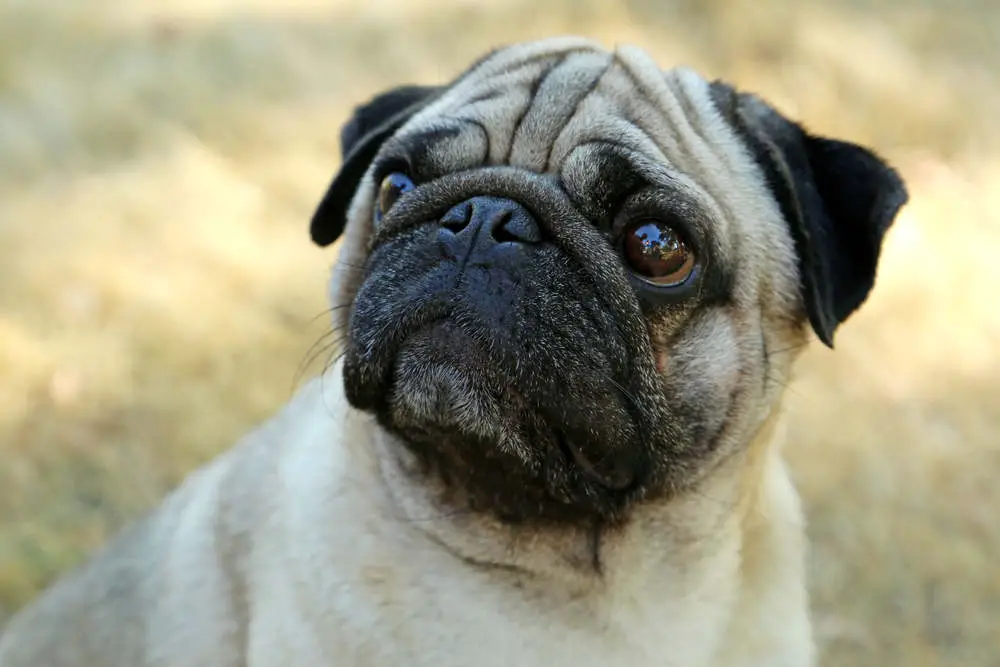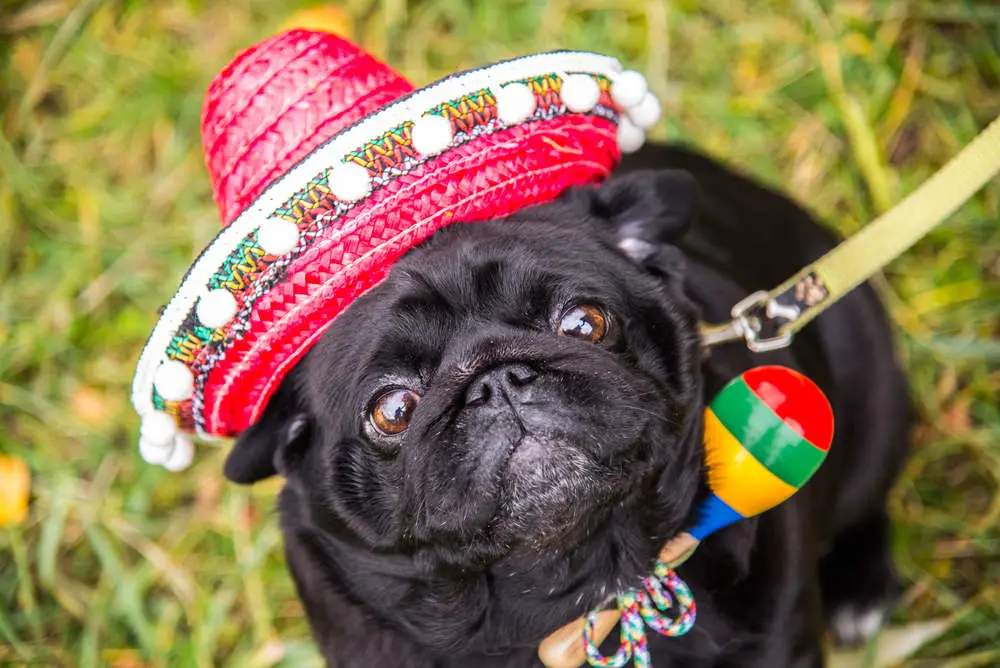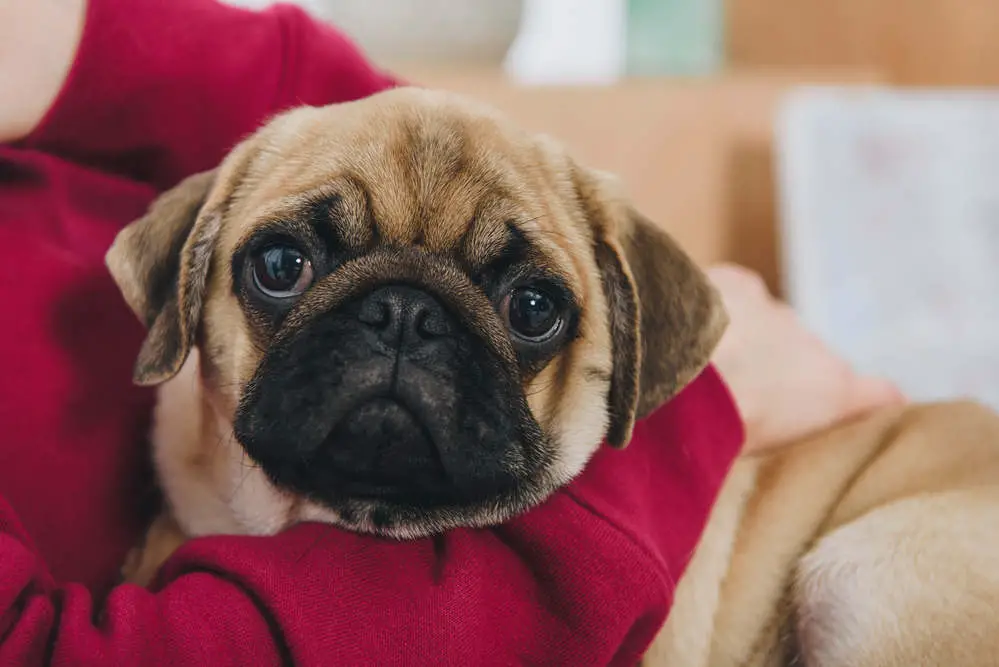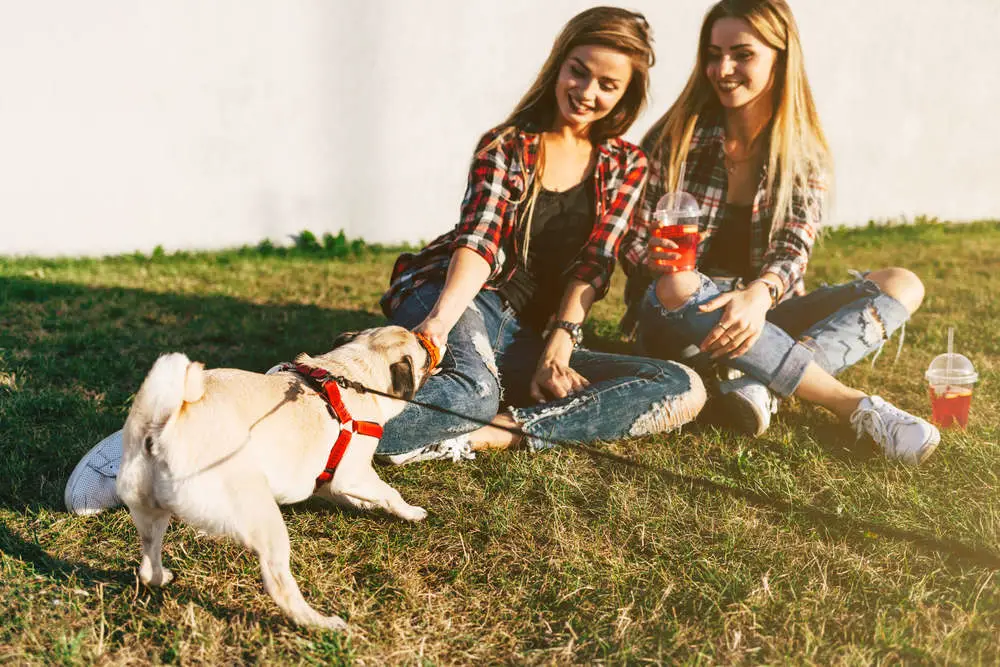
The pug can be called one of the original lap dogs because it was bred with this intention. It is a loving companion dog with a small frame but not as lightweight.
You will find this dog in two colors, black and fawn with some variations in the tone of the coat. Pugs are popular for their large and flat heads with wrinkled and comical facial expressions that make them an endearing pet.
But there is a lot more to them than their cute looks. Let’s take a look.
Pug: At a Glance
- Height: 10 to 13 inches
- Weight: 14 to 18 pounds
- Temperament: Playful, friendly with strangers
- Lifespan: 12 to 15 years
- Dog Breed Group: Companion dog
- Colors: Black and fawn
Origin
If pugs were superheroes, their origin story would have started in China during the Han dynasty. Some historians say that this breed has some relation with the Tibetan Mastiff and lived a luxurious life with the royals of China.
There were three types of ancient pugs that were bred by the Chinese—Pekingese, Lo-sze and the Lion Dog. As China established trade relations with Europe in the 1500s and 1600s, the dog made its way there through Dutch traders.
Even in Europe, pugs lived a royal lifestyle, even becoming the House of Orange’s official dog in Holland. When these royals went to England in 1688, they took their pugs with them. Different countries gave the breed their own name which is why they were called Mops in Germany, Carlin in France and Dogullo in Spain.
The breeding, though, was standardized in the 1800s and the first pug was exhibited in 1861. Meanwhile, when the British crossed paths with the Chinese in 1860, they brought some more of these little dogs to England.
The offspring of one of those pure Chinese dogs was named Click and is said to be the ancestor of the modern pug.
Throughout the Victorian Era, pugs remained extremely popular and the dog made its way to the US after the Civil War. In 1885, the American Kennel Club recognized the dog and ever since pugs have been extremely popular.
Related: What Were Pugs Bred For?
Pug Temperament and Behavior

These dogs are extremely affectionate and absolutely love it when you love them back. Pugs are called companion dogs and true to that label, they love snuggling up next to their human for hours at a time.
When they are not sleeping, these little dogs love lounging around and won’t hesitate to get under the covers with you. But if you think that’s a perk it is worth mentioning that these little guys are quite the snorers and can wheeze and snort in their sleep too.
But keeping them away will make them unhappy. And if you can’t take that, just get a pair of earplugs and you will be fine.
Related: Are Pugs Good Apartment Dogs?
The downside to all that attention seeking is that you cannot leave them alone for long periods of time. And they tend to get upset if you don’t reciprocate all the affection they are giving you.
Pugs are also not guard dogs, hunt or retrieve dogs. They like to stay at home and nap for 12 to 14 hours a day.
So, if you’re looking for a dog that is a running companion, they are not the one for you. They do like to play a little and short sessions of exercise are good for their health.
These are playful dogs and are capable of keeping themselves engaged to a certain extent. But if you’re lounging on the couch watching TV or reading a book, they will quickly come by your side and snuggle.
Related: Are Pugs Good With Kids?
Their attitude is mostly defined by the kind of training and socialization you put them through. They get along quite easily with strangers too, which is a relief if you have a big family.
The best thing to do as a pug parent is to meet at least one parent of your pup so that you have an idea of what your pup’s temperament will be like when they grow up. Failing that, meeting their siblings will also do the trick.
You might even want to consider getting them into puppy kindergarten so that they socialize and turn out to be a well-rounded canine.
Related: Are Pugs Hyper?
Caring for a Pug

When it comes to taking care of a pug, there are a few details you must note. Here’s a look at what it means to have a pug in the house.
Diet and Nutrition
Your pug might love you, but they might love eating a little more. They should be given two full meals every day.
That is half a cup of dry food but also do this with respect to their age and the amount of exercise they are getting on a daily basis. Their food needs change with age, which means you need to stay on top of the game.
It might be tempting but don’t give them too many treats or too much human food. Pugs have a genetic tendency to get obese which then turns into a health hazard.
Treats are a good way to motivate them while training but watch the sugar content and the quantity. They must also be given high-quality food whether it is store bought or made at home.
Pugs have adorable puppy eyes which may compel you to give in and leave table scraps but always remember the risk of obesity and being overweight.
Check with your vet on what’s best for your pug. And make sure you always keep clean and fresh drinking water accessible to your canine.
Possible Health Issues
Maintaining a pug might seem like the easiest thing because they don’t fuss over food and like to be lazy the whole day. But this breed comes with a range of possible health problems that might make things very difficult if you are not alert.
When pugs are bred by AKC standards, they are less likely to inherit some health problems but these are the ones you need to watch out for anyway.
- Brachycephalic Airway Obstruction Syndrome (BAOS): This is a problem among dogs that have a relatively short head. It is a respiratory problem that resists airflow and makes it hard for them to breathe. You will see some signs of it if your pug gets physically overworked. It leads to mouth breathing, noisy or rapid breathing and trouble breathing entirely. It can cause them to collapse and is fatal.
- Allergies: Pugs are prone to a range of allergies that can be related to their skin or the food they consume. If you notice them licking their paws or rubbing their face a little too much, you must take them to the vet.
- Corneal Ulcers: Pugs have big prominent eyes which makes it very possible for ulcers to grow on their cornea. If their eyes look red or the pug is squinting too much, you must take them to the vet. Usually, medication can solve the problem but if you neglect it, they may go blind.
- Granulomatous Meningoencephalitis or Pug Dog Encephalitis: PDE is a fatal disease that attacks the brain of the pug. It is not clear what causes it and there’s no test for it and it cannot be treated either. This is likely to affect young pugs and cause seizures. They also tend to circle and become blind over time. There is a genetic component to this disease.
- Epilepsy: Seizures can also be caused due to epilepsy and pugs are prone to a condition known as idiopathic epilepsy which causes seizures. Rush them to the vet and make sure you decide the appropriate course of treatment for your pup.
- Eye Problems: Since they have bulgy eyes, pugs encounter a lot of eye problems like the eyeball dislodging from the socket (proptosis), abnormally grown eyelashes at the end of the eye (distichiasis), a degenerative condition that affects the retinal cell and causes blindness and the lower eyelid rolling inwards (entropion).
- Yeast Infections: Pugs have wrinkles on their skin which is the perfect place for yeast to hide and cause infections. So, if your dog is feeling itchy or the skin is turning black in places it shouldn’t, you must take them to the vet. This is common on the feet, groin, neck, armpits and inside their ears which means you need to take extra measures when grooming the dog.
- Staph Infection: This is a fairly common skin problem but the hair follicles might also get infected if the immune system is compromised. You might also notice pimples on your dog’s face. This infection causes lesions that look like ringworms on areas without hair and like hives in places where they have hair.
- Hip Dysplasia: This is a problem not just for small dogs like pugs but also large breeds. It can occur because of genetics or their diet or the environment which causes a problem in the hip joint. Luckily if it is treatable and if you get them medical attention in time, they can lead a healthy life.
- Vaccination Sensitivity: This is a reported problem after the pug has been vaccinated. You might notice that your dog is feeling lethargic or is experiencing soreness, hives or swelling on the face. If you are not careful, this has the potential to turn into a lethal problem. So, the first few hours after a vaccination are critical. Rush to the vet if you notice any unusual behavior on your dog’s part.
Related: Why Do Pugs Fart So Much?
Training
Using treats is a great way to motivate pugs to train because they love food. Use the treats moderately to teach them basic commands so that they can be handled when needed.
Pugs actually respond quite well to training even though they are not crazy about physical activity. But they can be stubborn which needs to be smoothed out during this phase.
It gets difficult to trim their nails or get their attention if you don’t train them well. This is also a great time to engage their socialization skills.
Exercise
It must be clear to you by now that these dogs love to lounge around the house all day long. But since they are prone to gain weight and get obese, a little bit of exercise is necessary.
However, remember that they are not meant to get too tired because of their respiratory limitations. So, a 40-minute exercise session every day is a terrific idea.
In fact, you might even want to break it into two 20-minute sessions so that your little guy has a moment to catch his breath.
Remember that pugs are sturdy and playful animals. And while they are not the biggest fans of games like fetch, they do like to do short walks and short play sessions in and around the house.
They also don’t do very well when it is very hot outside so, don’t strain them when it is humid or if the mercury is on the rise.
Related: Can Pugs Swim?
Grooming
Pugs have a short and smooth coat. It doesn’t need too much maintenance but they do shed a bit.
So, prepare to brush their coat once a week with a medium-bristled brush. You must also keep a grooming mitt handy so that the loose hair can be easily removed.
About bathing. You don’t need to give them too many showers unless they start to smell or do something to get themselves dirty which is a relief.
But remember that grooming isn’t only about giving them showers. Since pugs are prone to infections because of parasitic growth in the folds of their skin, make sure you clean the wrinkled areas of their body regularly.
While you are at it, also trim their nails because long nails make them uncomfortable.
Your dog’s teeth must also be brushed twice a week so that their teeth and gums remain healthy. This breed is prone to dental problems which means cleanings are not out of order.
Should You Get a Pug?

This depends on where you live, what kind of a lifestyle you have and how much time you can spare for your pet.
Pros
- Great for those who want indoor pets because pugs don’t like going out all that much.
- Pugs love to cuddle and snuggle when they are not sleeping.
- They will follow you around all day and wait for you to show some affection.
- These are playful dogs that love get-togethers.
- Pugs get along with strangers quite easily.
- They are of sound temperament.
Cons
- They are stubborn and it can be a challenge to get them used to the house.
- Pugs don’t do well in hot and humid climates if there is no air conditioning. They also get overheated quite easily when they are outside.
- They are prone to many genetic and other health conditions which require care.
- Pugs have a short coat but shed quite a bit.
- This breed of dogs wheeze and snore loudly.
- These dogs are greedy eaters and tend to get overweight quite easily.
Also Read: Pug vs Westie Dog Breed Comparison
Wrapping Up
There are lots of great things about a pug. They are quiet, friendly with strangers and affectionate towards anyone after the initial ice-breaking session.
They are playful and like to sleep a lot. Pugs also love to cuddle for most of their waking hours which makes them great companion dogs.
But if you encourage them all the time they might have trouble being on their own when there is no one around for too long. They also love to eat but are prone to obesity which means you need to be careful with table scraps.
Pugs are also genetically predisposed to a lot of health problems. So, while you are chilling with them on the couch, take a minute to see if they are doing okay.
